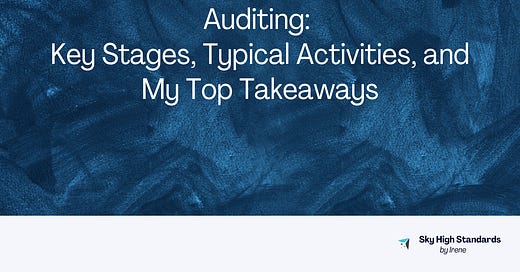Auditing: Key Stages, Typical Activities, and My Top Takeaways
An audit is a multi-stage process. ISO 19011:2018 guides audits, soon replaced by ISO/DIS 19011. I’ll share key experiential insights.
An audit is not an independent activity; it is a process consisting of multiple stages, each comprising different activities.
ISO 19011:2018 establishes the “Guidelines for auditing management systems”.
It defines the core principles of auditing, guides the management of audit programs, and provides a structured approach to conducting management system audits.
By establishing a unified framework, it ensures audits are carried out with consistency and efficiency. It’s withdrawal has been proposed though in the near future by the ISO/DIS 19011.
Today, I am focusing on the phases of conducting the audit process, as the management of the audit program will be covered in Part 3 of the series as well are audit records in Part 4.
These are:
(6.2) Initiating audit
(6.3) Preparing audit activities
(6.4) Conducting audit activities
(6.5) Preparing and distributing audit report
(6.6) Completing audit
(6.7) Conducting audit follow-up
However, rather than summarizing or repeating what the standard states, I will focus on my 3 top key takeaways or considerations I have learned through my experience for each phase.
This is part of the fortnightly six-part mini-series, where I cover:
Part 1: The Audit, the role and the competencies of the Auditor
Part 2: The Key Stages of the Audit Process and Typical Audit Activities
Part 3: The Key Aspects before starting an Auditing
Part 4: My Fundamentals of Audit Work Documents and Reporting
Part 5: Communication and Auditing – The Biggest Challenge
Part 6: My Key Takeaways
Let’s dive in! 🤿
Initiating the audit
This phase sets the foundation for the audit. It includes defining the objectives, scope, and criteria, selecting the audit team, notifying auditees, and addressing logistical considerations. Proper initiation ensures a smooth and effective audit process.
Whilst I will focus on the definition of the objectives, scope, and criteria in the Part 3, my top 3 considerations from experience are:
Set the right tone from the start: the initial approach impacts how the audit is received. If framed as a collaborative improvement effort rather than a compliance check, you’ll gain better cooperation. Make sure that top management understands the audit's scope and goals. If their expectations don’t align with reality, it can cause friction later.
Consider previous audit history: reviewing past findings helps identify recurring issues and areas needing deeper investigation, rather than treating each audit as a blank slate.
Align with ongoing business priorities: be aware of operational constraints. Conducting an audit during peak production or a major system transition can impact cooperation and effectiveness.
Preparing the audit activities
This phase focuses on planning the audit in detail, including reviewing documentation, defining an audit plan, assigning roles, preparing checklists, and coordinating logistics.
My top 3 considerations from experience are:
Prioritize high-risk areas: focus efforts where they matter most, such as critical processes, recurring issues, or areas with high regulatory impact.
Ensure clarity in the audit plan: a well-structured but adaptable plan helps maintain focus and ensures alignment with audit objectives.
Use checklists, but stay flexible: while checklists provide structure, real insights often come from observations, open-ended questioning, and interactions with auditees.
Conducting the audit activities
This is the execution phase where auditors perform document reviews, conduct interviews, observe processes, and gather objective evidence to assess compliance and effectiveness.
My top 3 considerations from experience are:
Create a comfortable environment for auditees: an overly formal or intimidating approach can lead to rehearsed answers. Build rapport to encourage openness.
Observe more, talk less: process observations often reveal more than interviews alone. Walk the floor, watch workflows, and look beyond what’s on paper.
Ask "why?" more than once: don’t settle for surface-level explanations. Use follow-up questions to uncover the root cause of non-conformities.
Preparing and distributing the audit report
The audit report documents findings, conclusions, and recommendations. It should be clear, factual, and structured in a way that facilitates corrective action.
My top 3 considerations from experience are:
Keep it clear and actionable: avoid technical jargon and vague language. Findings should be easily understood and lead to concrete actions.
Highlight strengths, not just weaknesses: a well-balanced report that acknowledges good practices increases buy-in for improvement efforts.
Ensure the report is fact-based, not opinion-based: findings should be supported by objective evidence, avoiding subjective interpretations.
Completing the audit
This phase finalizes the audit, including holding a closing meeting, obtaining auditee acknowledgement, and setting the stage for corrective actions.
My top 3 considerations from experience are:
Hold a meaningful closing meeting: ensure auditees clearly understand the findings and what’s expected in terms of corrective actions. No surprises.
Get auditee acknowledgement (not necessarily agreement): auditees don’t have to agree with findings, but they must understand and acknowledge them.
Set the stage for follow-up: Ensure corrective actions are tracked and assigned, with clear deadlines and accountability.
Conducting the audit follow-up
This phase ensures corrective actions have been implemented effectively and that identified issues are truly resolved, not just closed on paper.
Top 3 Considerations from Experience
Focus on effectiveness, not just completion: a closed corrective action doesn’t mean the problem is solved. Verify that the root cause was addressed.
Avoid a "tick-the-box" mentality: some auditees rush corrective actions just to close findings. Dig deeper to ensure meaningful improvement.
Maintain momentum until the next audit: keep improvement discussions ongoing, making audits a tool for continuous enhancement rather than just periodic compliance.
That’s all for today.
In two weeks I will focus on the The Key Aspects before starting an Auditing.
Stay tuned! 🚀 See you next week. 👋
Disclaimer: The information provided in this newsletter and related resources is intended for informational and educational purposes only. It reflects both researched facts and my personal views. It does not constitute professional advice. Any actions taken based on the content of this newsletter are at the reader's discretion.




Gracias Juan! 👍
Muy interesante desde tú “magnífica experiencia” 👍
Gracias